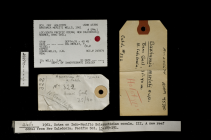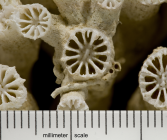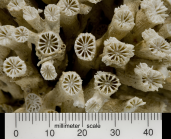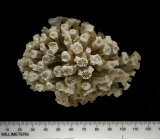
Chinese
Register of
Marine Species
(ChaRMS)
Register of
Marine Species
(ChaRMS)
| Intro | | Search taxa | | Taxon tree | | Sources | | Statistics | | Editors | | Log in |
WoRMS taxon detailsBlastomussa Wells, 1968
205647 (urn:lsid:marinespecies.org:taxname:205647)
accepted
Genus
Bantamia merleti Wells, 1961 accepted as Blastomussa merleti (Wells, 1961) (type by original designation)
Blastomussa (Blastomussa) Wells, 1968 · unaccepted > junior objective synonym
Blastomussa (Ceriomorpha) Head, 1978 · unaccepted > junior subjective synonym
Ceriomorpha Head, 1978 · unaccepted > junior subjective synonym
Parasimplastrea Sheppard & Sheppard, 1991 · unaccepted > junior subjective synonym
marine,
Wells JW. (1968). Notes on Indo-Pacific scleractinian corals. Part 5, A new species of Alveopora from New Caledonia. <em>Pacific Science.</em> 22: 274-275., available online at https://scholarspace.manoa.hawaii.edu/bitstream/10125/6828/v22n2-274-276.pdf
page(s): 276 [details]
Description Colonies are phaceloid with irregularly spaced sprawling corallites. Corallites have one centre with a weakly developed...
Description Colonies are phaceloid with irregularly spaced sprawling corallites. Corallites have one centre with a weakly developed columella. Septa slope gently to the corallite centre and have lobed teeth. Corallite walls are enveloped with, and often joined by epitheca. Polyps have fleshy mantles extended during the day to form a continuous cover obliterating the phaceloid colony structure underneath. Polyps are extended only at night. Both species have two colour morphs, one being red. (Veron, 1986 <57>) [details]
Hoeksema, B. W.; Cairns, S. (2024). World List of Scleractinia. Blastomussa Wells, 1968. Accessed through: World Register of Marine Species at: https://www.marinespecies.org/aphia.php?p=taxdetails&id=205647 on 2024-09-20
Date action by 2006-09-06 06:55:51Z changed Martinez, Olga
original description
Wells JW. (1968). Notes on Indo-Pacific scleractinian corals. Part 5, A new species of Alveopora from New Caledonia. <em>Pacific Science.</em> 22: 274-275., available online at https://scholarspace.manoa.hawaii.edu/bitstream/10125/6828/v22n2-274-276.pdf
page(s): 276 [details] original description (of Parasimplastrea Sheppard & Sheppard, 1991) Sheppard CRC, Sheppard ALS. (1991). Corals and coral communities of Saudi Arabia. <em>Fauna of Saudi Arabia.</em> 12: 1-170. [details] original description (of Blastomussa (Ceriomorpha) Head, 1978) Head, S.M. 1978. A cerioid species of Blastomussa (Cnidaria, Scleractinia) from the central Red Sea, with a revision of the genus. Journal of Natural History 12: 633-639. [details] taxonomy source Rowlett J. (2020). Indo-Pacific Corals. <em>Rowlett (self-published).</em> pp. 1-809. [details] context source (Hexacorallia) Fautin, Daphne G. (2013). Hexacorallians of the World. (look up in IMIS) [details] basis of record Veron JEN. (1986). Corals of Australia and the Indo-Pacific. <em>Angus & Robertson Publishers.</em> [details] additional source Veron JEN, Pichon M. (1980). Scleractinia of Eastern Australia – Part III. Family Agariciidae, Siderastreidae, Fungiidae, Oculinidae, Merulinidae, Mussidae, Pectinidae, Caryophyllidae, Dendrophylliidae. <em>Australian Institute of Marine Science Monograph Series.</em> 4: 1-459. [details] additional source Veron JEN. (2000). Corals of the World. Vol. 1–3. <em>Australian Institute of Marine Science and CRR, Queensland, Australia.</em> [details] additional source Head, S.M. 1978. A cerioid species of Blastomussa (Cnidaria, Scleractinia) from the central Red Sea, with a revision of the genus. Journal of Natural History 12: 633-639. [details] additional source Budd AF, Fukami H, Smith ND, Knowlton N. (2012). Taxonomic classification of the reef coral family Mussidae (Cnidaria: Anthozoa: Scleractinia). <em>Zoological Journal of the Linnean Society.</em> 166 (3): 465-529., available online at https://doi.org/10.1111/j.1096-3642.2012.00855.x [details] additional source Cairns, S.D., R. Baron-Szabo, A.F. Budd, B. Lathuilière, E. Roniewicz, J. Stolarski & K.G. Johnson. (2010). Corallosphere. , available online at http://www.corallosphere.org [details] additional source Chevalier JP. (1975). Les Scléractiniaires de la Mélanésie Française (Nouvelle-Caledonie, Iles Chesterfield, Iles Loyauté, Nouvelles Hébrides). II. Expedition Française sur les Récifs Coralliens Nouv.-Calédonie. 7: 1-407, pls. 1-42. Paris. [details] additional source Benzoni F, Arrigoni R, Waheed Z, Stefani F, Hoeksema BW (2014) Phylogenetic relationships and revision of the genus Blastomussa (Cnidaria: Anthozoa: Scleractinia) with description of a new species. Raffles Bulletin of Zoology 62: 358-378. [details] additional source Neave, Sheffield Airey. (1939-1996). Nomenclator Zoologicus vol. 1-10 Online. <em>[Online Nomenclator Zoologicus at Checklistbank. Ubio link has gone].</em> , available online at https://www.checklistbank.org/dataset/126539/about [details]  Present Present  Inaccurate Inaccurate  Introduced: alien Introduced: alien  Containing type locality Containing type locality
From editor or global species database
Biology zooxanthellate [details]From other sources
Description Colonies are phaceloid with irregularly spaced sprawling corallites. Corallites have one centre with a weakly developed columella. Septa slope gently to the corallite centre and have lobed teeth. Corallite walls are enveloped with, and often joined by epitheca. Polyps have fleshy mantles extended during the day to form a continuous cover obliterating the phaceloid colony structure underneath. Polyps are extended only at night. Both species have two colour morphs, one being red. (Veron, 1986 <57>) [details]
To Biological Information System for Marine Life (BISMaL)
To European Nucleotide Archive, ENA (Blastomussa) To European Nucleotide Archive, ENA (Parasimplastrea) (from synonym Parasimplastrea Sheppard & Sheppard, 1991) To Genbank (from synonym Parasimplastrea Sheppard & Sheppard, 1991) To Genbank To ITIS |




